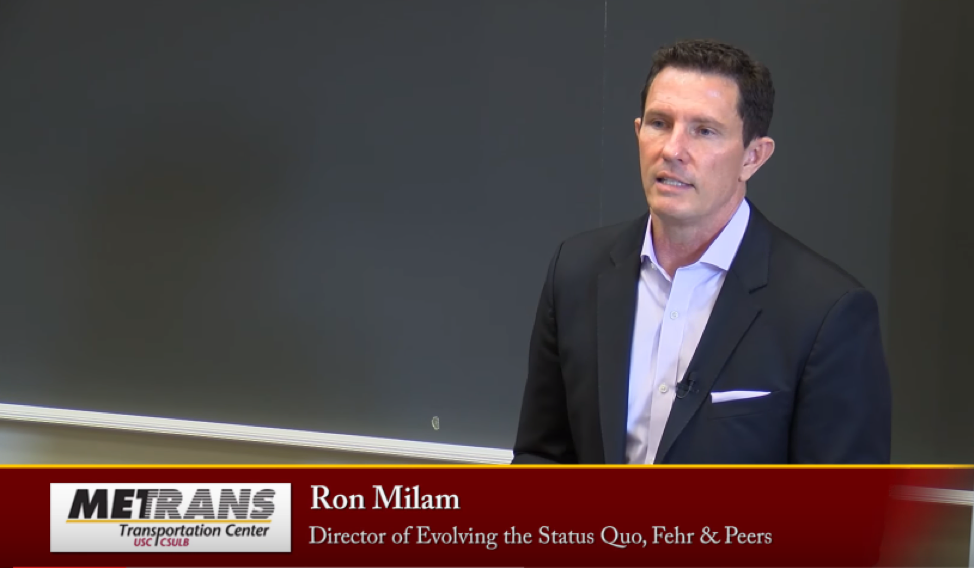News | Ronald Milam Shares Travel Behavior Implications of Disruptive Trends and Autonomous Vehicles
Stop the VideoNews

METRANS UTC
Ronald Milam Shares Travel Behavior Implications of Disruptive Trends and Autonomous Vehicles
Tuesday, April 16, 2019
by By: Kavina Patel and Spencer Wejrowski, USC Price Master of Planning Students
On Tuesday, March 19th, 2019, METRANS, PSR, and the USC Viterbi School of Engineering invited Ronald Milam to bring critical perspectives and recent research on the travel behavior implications of disruptive trends and autonomous vehicles (AVs) to the USC campus. Milam is the director of evolving the status quo at Fehr & Peers and leads the company’s research and development. His work revolves around travel market priorities, disruptive trends such as internet shopping and automated vehicles, and using big data analysis to answer challenging transportation policy and technical questions.
Professor James Moore introduced Milam and his recent work and collaborative efforts with UC Berkeley. Milam then took the stage to present new research undertaken by Fehr & Peers. At the outset of this new research, Milam and his team identified 16 different trend variables expected to influence the future of travel. Milam focused his presentation on several major ones, including Transportation Network Companies (TNCs), shared mobility, and autonomous vehicles.

Many of the trends had a clear relationship amongst them. For example, the number of Vehicle Miles Travelled (VMT) mirrored the economic growth from 1970 to 2004. Another logical trend was that lower fuel prices correlated with people driving more; higher fuel prices encouraged carpooling and car sharing. In 2008, TNCs started and created brand new vehicle trips; 60% of TNC trips were new vehicle trips. Milam noted that these trips impact transit ridership. The traditional pattern is that as employment increases, so does transit ridership. However, Milam found that this was no longer the case. It had to do with the TNCs growing mode share in 2015 and Uber/Lyft launching car-pooling. An exception was Seattle, most likely due to its massive investment in transit.
And now we have bike share, e-scooters, and other micro-transit. With all of these options to get from point A to point B, Milam asked the audience, “What is coming next?”
“In the future, we think autonomy.” He goes on to say that autonomous could be anything. It could be autonomous vehicles or transit or both, and this could once again change travel behavior significantly. Although it is not known exactly when AVs are coming in the market, most agree that they are inevitable. Milam noted that experts cluster around a prediction of 80% of vehicles being autonomous by 2040.
Milam cautioned that an important aspect of planning for the future of AVs is the policy response to the future growth. The current policy response to travel is going to determine the desired future outcome, such as the way we price travel. To reduce VMT and increase transit ridership, transit needs to be more desirable and a competitive option. And the competition is increasingly stiff. With Uber/Lyft operators as service providers, transit, more than ever, needs to be convenient, efficient, and comfortable.
Milam concluded his presentation by posing a sample of the many remaining questions of what a future with private autonomous vehicles will bring. Will AVs facilitate prostitution or other Illicit or illegal behavior? Will AVs serve terrorists by sending armed cars to desired locations? Will autonomous vehicle service be equitable? Will they serve all communities equally and fairly? Will autonomous vehicles integrate well into the flow of traffic? Milam emphasized that it is time to lay the groundwork for an AV future.
News Archive
- December (1)
- November (6)
- October (4)
- September (2)
- August (3)
- July (4)
- June (3)
- May (7)
- April (8)
- March (11)
- February (8)
- January (7)
- December (7)
- November (8)
- October (11)
- September (11)
- August (4)
- July (10)
- June (9)
- May (2)
- April (12)
- March (8)
- February (7)
- January (11)
- December (11)
- November (5)
- October (16)
- September (7)
- August (5)
- July (13)
- June (5)
- May (5)
- April (7)
- March (5)
- February (3)
- January (4)
- December (4)
- November (5)
- October (5)
- September (4)
- August (4)
- July (6)
- June (8)
- May (4)
- April (6)
- March (6)
- February (7)
- January (7)
- December (8)
- November (8)
- October (8)
- September (15)
- August (5)
- July (6)
- June (7)
- May (5)
- April (8)
- March (7)
- February (10)
- January (12)















